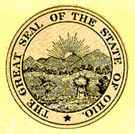The Making of the 50 States: Ohio
Part 2: The Rest of the Story Part 2: The Rest of the Story The Native Americans who lived in Ohio grew corn (eight- and ten-row), beans (kidney, navy, and pinto), squash, pumpkins, turnips, cabbage, parsnips, sweet potatoes, leeks, and melons. Europeans began to move into the Ohio Territory in the mid-to-late 1700s, bringing with them wheat, oats, barley, rye, buckwheat, and potatoes. European settlers also grew tobacco, which many people at that time had medicinal qualities. Fruits grown included apples, grapes, and peaches. During all of the American-Native American struggles, settlers from the east continued to pour in to Ohio. Many larger cities developed factories that churned out crops and goods in record numbers. Dayton, for instance was a major tobacco processing plant. Cincinnati was known as "Porkopolis" for its amazing pork production. Steubenville had a major wool mill that employed more than 100 people. Cyrus McCormick, inventor of the reaper, lived in Ohio for a time during the 1830s. Because agriculture was such a dominant industry, many workers were paid in wheat or corn rather than with money.
The drive toward statehood was a political affair, as members of the two major political parties of the The Enabling Act also called for a state convention, with attending delegates to discuss a state constitution. This convention began in November 1802. The delegates were split along party lines, with two delegates belonging to neither party. Most of the delegates, 26 of the 35, were Democratic-Republicans, however, and so the state constitution blueprint that the convention as a whole drafted included provisions for a weak central government, one of the main political beliefs of the Democratic-Republican Party. Northwest Territory Governor St. Clair, a Federalist, got involved, giving a speech that urged his fellow Federalists to hold out for something more to their liking. Then-President Thomas Jefferson, himself a Democratic-Republican, removed St. Clair from office and ordered the state constitution approved as it was. In the end, only one Federalist opposed the constitution.
Among the provisions of the state constitution was a legislative branch that had power over the governor in that he couldn't veto any laws passed by the two houses of the General Assembly, the House and Senate. Representatives served only one year, and Senators served two. The General Assembly also selected state judges and had approval power over the governor's appointments. Slavery was prohibited in the new state of Ohio, although African-Americans could not vote. First page > In the Beginning > Page 1, 2
|
|
Social Studies for Kids
copyright 2002–2024
David White



 The expansion of the Ohio Territory brought with it more and more people, making direct connection with the East Coast desirable. The
The expansion of the Ohio Territory brought with it more and more people, making direct connection with the East Coast desirable. The  time, the
time, the  The final vote was taken and ratified on November 29, 1802. The United States Congress approved the constitution on February 19, 1803, and Ohio became the 17th state on that day. (Ohio celebrates statehood on March 1, the day the state General Assembly first met.
The final vote was taken and ratified on November 29, 1802. The United States Congress approved the constitution on February 19, 1803, and Ohio became the 17th state on that day. (Ohio celebrates statehood on March 1, the day the state General Assembly first met.
